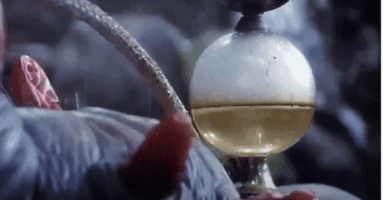Spider-Sense Is Real: Small Animals Experience Time Slower Than Larger Creatures
 Over the course of a human year, dogs age seven years — or at least, that’s how the saying goes. Is that a way of making it seem like dogs are living a human-length life span, or is that because, to a dog, one year feels like seven? Is it possible that dogs actually experience time differently than humans?
Over the course of a human year, dogs age seven years — or at least, that’s how the saying goes. Is that a way of making it seem like dogs are living a human-length life span, or is that because, to a dog, one year feels like seven? Is it possible that dogs actually experience time differently than humans?
I wonder this a lot about my cat. Whether I’ve run to the store on a 10-minute errand or have been in Portugal for a month, she’s all over me the minute I walk in the door, as though there’s no difference in the time I’ve been away. She can’t seem to tell 10 minutes from 10 hours from 10 days — is that because she doesn’t own a watch or because her experience of time is wonky, or at least different from ours?
I can’t speak for Zola, but a new study published by Trinity College Dublin scientists in Animal Behaviour indicates that smaller animals perceive the passage of time much more slowly. It’s kind of like that thing Kiera Cameron does to slow time down enough to dodge bullets, except that animals use this time perception difference to escape bigger predators. Ever wonder why a fly seems to be able to detect and evade the swatter you’ve painstakingly poised just above it? Ever wonder why you’re sure you just smashed a mosquito between your hands, but when you open them, there’s nothing? It’s essentially a time and vision-related spider sense. Similarly, bigger animals have the opposite problem, missing details easily detected by smaller animals.
The animals with the fastest visual systems include squirrels, starlings, and pigeons. Maybe this is how pigeons appear to be absolutely everywhere all the time. Starlings fly in big bunches, and their enhanced abilities may help them avoid mid-air collisions (see the video below). The team found that a particular kind of tiger beetle moves more quickly than its eyes can register data, resulting in temporary blindness that forces it to stop and confirm the location of its prey. And squirrels need to keep track of those fast-moving acorns.
While some species of flies can react four times faster than humans, the study found that the slowest reactions belonged to marine woodlice. I think that’s a good thing for the rest of us. In an experiment, these poor nasties couldn’t register the turning on and off of a light more than four times a second — instead, it just saw the light as on all the time. The leatherback turtle, blacknose shark, and European eel also had slow visual systems, which makes sense given their slow metabolisms. And, of course, what the animals do with the information matters — flies might not be particularly contemplative, but they can react very quickly.
It turns out that humans possess varying abilities to process visual information as well. Athletes are a prime example, largely because they’ve trained themselves to register certain information more quickly. Visual processing speed also decreases over time. The scientists also believe that body size might impact how quickly the eye reacts to visual stimuli. I guess I should be better able to evade my predators then?












